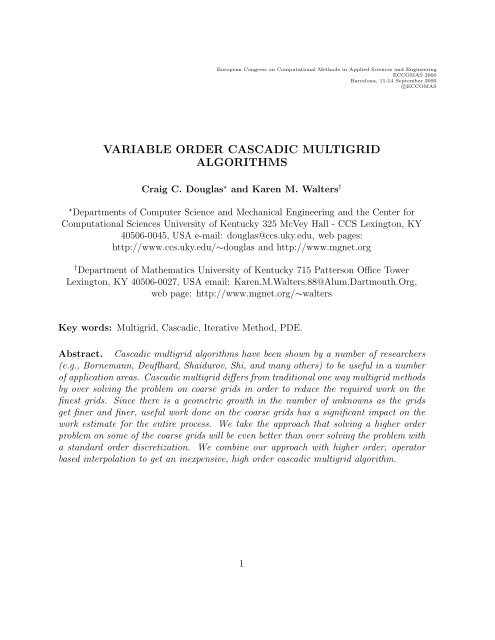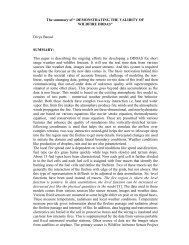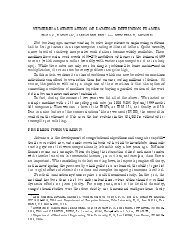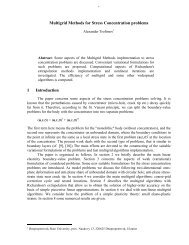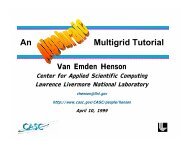European Congress on Computational Methods in Applied ... - MGNet
European Congress on Computational Methods in Applied ... - MGNet
European Congress on Computational Methods in Applied ... - MGNet
You also want an ePaper? Increase the reach of your titles
YUMPU automatically turns print PDFs into web optimized ePapers that Google loves.
<str<strong>on</strong>g>European</str<strong>on</strong>g> <str<strong>on</strong>g>C<strong>on</strong>gress</str<strong>on</strong>g> <strong>on</strong> Computati<strong>on</strong>al <strong>Methods</strong> <strong>in</strong> <strong>Applied</strong> Sciences and Eng<strong>in</strong>eer<strong>in</strong>gECCOMAS 2000Barcel<strong>on</strong>a, 11-14 September 2000c○ECCOMASVARIABLE ORDER CASCADIC MULTIGRIDALGORITHMSCraig C. Douglas ⋆ and Karen M. Walters †⋆ Departments of Computer Science and Mechanical Eng<strong>in</strong>eer<strong>in</strong>g and the Center forComputati<strong>on</strong>al Sciences University of Kentucky 325 McVey Hall - CCS Lex<strong>in</strong>gt<strong>on</strong>, KY40506-0045, USA e-mail: douglas@ccs.uky.edu, web pages:http://www.ccs.uky.edu/∼douglas and http://www.mgnet.org† Department of Mathematics University of Kentucky 715 Patters<strong>on</strong> Office TowerLex<strong>in</strong>gt<strong>on</strong>, KY 40506-0027, USA email: Karen.M.Walters.88@Alum.Dartmouth.Org,web page: http://www.mgnet.org/∼waltersKey words: Multigrid, Cascadic, Iterative Method, PDE.Abstract. Cascadic multigrid algorithms have been shown by a number of researchers(e.g., Bornemann, Deuflhard, Shaidurov, Shi, and many others) to be useful <strong>in</strong> a numberof applicati<strong>on</strong> areas. Cascadic multigrid differs from traditi<strong>on</strong>al <strong>on</strong>e way multigrid methodsby over solv<strong>in</strong>g the problem <strong>on</strong> coarse grids <strong>in</strong> order to reduce the required work <strong>on</strong> thef<strong>in</strong>est grids. S<strong>in</strong>ce there is a geometric growth <strong>in</strong> the number of unknowns as the gridsget f<strong>in</strong>er and f<strong>in</strong>er, useful work d<strong>on</strong>e <strong>on</strong> the coarse grids has a significant impact <strong>on</strong> thework estimate for the entire process. We take the approach that solv<strong>in</strong>g a higher orderproblem <strong>on</strong> some of the coarse grids will be even better than over solv<strong>in</strong>g the problem witha standard order discretizati<strong>on</strong>. We comb<strong>in</strong>e our approach with higher order, operatorbased <strong>in</strong>terpolati<strong>on</strong> to get an <strong>in</strong>expensive, high order cascadic multigrid algorithm.1
Craig C. Douglas and Karen M. Walters1 INTRODUCTIONMultigrid is an approach to computati<strong>on</strong>al problem solv<strong>in</strong>g orig<strong>in</strong>ally developed tosolve boundary value problems aris<strong>in</strong>g <strong>in</strong> physical applicati<strong>on</strong>s. A set of grid po<strong>in</strong>ts ischosen <strong>in</strong> the doma<strong>in</strong> of the problem. Us<strong>in</strong>g a discretizati<strong>on</strong> process, we get a system ofalgebraic equati<strong>on</strong>s that is associated with the chosen grid po<strong>in</strong>ts and whose soluti<strong>on</strong> isan approximati<strong>on</strong> to the c<strong>on</strong>t<strong>in</strong>uous problem.A sequence of related problems is generated <strong>on</strong> coarser and coarser grids, where thesoluti<strong>on</strong> <strong>on</strong> a particular grid is a good approximati<strong>on</strong> to the soluti<strong>on</strong> <strong>on</strong> the next f<strong>in</strong>er grid.Alternately, a coarse grid problem is solved and then (adaptively or uniformly) ref<strong>in</strong>eduntil a f<strong>in</strong>e enough grid is generated that adequately solves the problem.A restricti<strong>on</strong> operator maps an approximate soluti<strong>on</strong> <strong>on</strong> <strong>on</strong>e level to the next coarserlevel. This can be, for example, a direct <strong>in</strong>jecti<strong>on</strong> of po<strong>in</strong>ts or a weighted average of eachgrid po<strong>in</strong>t with its nearest neighbors. An <strong>in</strong>terpolati<strong>on</strong> operator takes an approximatesoluti<strong>on</strong> and maps it to the next f<strong>in</strong>er grid.The V cycle is the basic multigrid algorithm.h2h4h8hFigure 1: Four level V cycleWe start with a problem <strong>on</strong> the f<strong>in</strong>est level. A smoother (e.g., Gauss-Seidel) or rougher(e.g., c<strong>on</strong>jugate gradients) is used <strong>on</strong> this level to damp the high frequency comp<strong>on</strong>entsof the error. The residual is computed and projected to the next coarser level where theresidual problem is solved with an <strong>in</strong>itial guess of zero.This process is repeated down to the coarsest level, where we compute the soluti<strong>on</strong>to the residual problem (typically with a direct solver). Then we correct the soluti<strong>on</strong> <strong>on</strong>the next f<strong>in</strong>er grid by add<strong>in</strong>g an <strong>in</strong>terpolati<strong>on</strong> of the coarse grid correcti<strong>on</strong> to the exist<strong>in</strong>gsoluti<strong>on</strong> <strong>on</strong> this f<strong>in</strong>er level. On the next f<strong>in</strong>er level, we smooth the problem and <strong>in</strong>terpolateour new correcti<strong>on</strong> up to the next f<strong>in</strong>er level where we aga<strong>in</strong> correct the exist<strong>in</strong>g soluti<strong>on</strong>.This c<strong>on</strong>t<strong>in</strong>ues until we reach the f<strong>in</strong>est level, where we smooth aga<strong>in</strong> to get our f<strong>in</strong>alsoluti<strong>on</strong>.The full multigrid cycle is composed of a series of nested V cycles.2
Craig C. Douglas and Karen M. Waltersh2h4h8hFigure 2: Four level full multigrid cycleThis algorithm beg<strong>in</strong>s <strong>on</strong> the coarsest level. The idea here is to get a good <strong>in</strong>itial guessfor a particular level before do<strong>in</strong>g any process<strong>in</strong>g <strong>on</strong> that level.The cascadic multigrid algorithm differs from the full multigrid cycle <strong>in</strong> that it is a <strong>on</strong>eway multigrid start<strong>in</strong>g at the coarsest level and c<strong>on</strong>t<strong>in</strong>u<strong>in</strong>g to the f<strong>in</strong>est level without evergo<strong>in</strong>g back for a correcti<strong>on</strong>.h2h4h8hFigure 3: Four level Cascadic multigrid cycleCascadic multigrid evolved from the Cascade Pr<strong>in</strong>ciple of Deuflhard, Le<strong>in</strong>en, and Yserentant[5]. The ma<strong>in</strong> feature of this method is that the iterati<strong>on</strong> is term<strong>in</strong>ated by an adaptivec<strong>on</strong>trol as so<strong>on</strong> as the algebraic error is c<strong>on</strong>siderably below the discretizati<strong>on</strong> error.A prime feature of cascadic multigrid is that more smooth<strong>in</strong>g iterati<strong>on</strong>s are d<strong>on</strong>e <strong>on</strong> thecoarser levels <strong>in</strong> the hope that fewer smooth<strong>in</strong>g iterati<strong>on</strong>s are needed <strong>on</strong> the f<strong>in</strong>er levels,i.e., we over solve the problem <strong>on</strong> the coarser levels. This does not make sense from theapproximati<strong>on</strong> theory viewpo<strong>in</strong>t s<strong>in</strong>ce we can really <strong>on</strong>ly solve up to the truncati<strong>on</strong> error<strong>on</strong> these levels, which is normally all that multigrid does.The motivati<strong>on</strong> for cascadic multigrid comes from numerical l<strong>in</strong>ear algebra, not approximati<strong>on</strong>theory, however. Once the c<strong>on</strong>t<strong>in</strong>uous problem is discretized <strong>on</strong> all of thelevels, we are <strong>on</strong>ly go<strong>in</strong>g to run the smoother <strong>on</strong> each level until the residual norm isreduced to some (fixed) size (e.g., 10 −4 or 10 −6 ). We over solve <strong>in</strong> the hope that we get abetter <strong>in</strong>itial guess when we <strong>in</strong>terpolate to the f<strong>in</strong>er levels.3
Craig C. Douglas and Karen M. WaltersThis actually works some of the time though it still depends <strong>on</strong> the approximati<strong>on</strong>properties of the soluti<strong>on</strong>. For example, we could have higher derivatives blow<strong>in</strong>g up, orwe could have the case where the l<strong>in</strong>ear algebra system <strong>on</strong> a level is not related closelyenough to the system <strong>on</strong> the previous level, <strong>in</strong> which case our approximati<strong>on</strong> will not begood enough. However, for well behaved soluti<strong>on</strong>s, cascadic multigrid works well <strong>in</strong> somevery difficult applicati<strong>on</strong>s.Shaidurov [7] showed that the cascadic c<strong>on</strong>jugate gradient method (CCGM) is accuratewith optimal complexity for elliptic problems <strong>in</strong> two dimensi<strong>on</strong>s and for quasi-uniformtriangulati<strong>on</strong>s. Note that optimality here is with respect to the energy norm. However,Bornemann and Krause [2] showed that cascadic multigrid cannot be optimal with respectto the L 2 norm.Bornemann and Deuflhard [1] simplified and extended Shaidurov’s results. Theyshowed that the three dimensi<strong>on</strong>al problem is accurate with optimal complexity for anychoice of energy reduc<strong>in</strong>g smoother (e.g., symmetric Gauss-Seidel, SSOR, damped Jacobi,or c<strong>on</strong>jugate gradients). They also showed that the two dimensi<strong>on</strong>al problem has optimalcomplexity us<strong>in</strong>g c<strong>on</strong>jugate gradients, and is nearly optimal for the standard iterativesmoothers.Braess and Dahmen [3] looked at the Stokes problem. They discovered that specialtreatment is needed for the transfer operators. They obta<strong>in</strong>ed optimality for saddle po<strong>in</strong>tproblems. They also found that their technique is useful for n<strong>on</strong>c<strong>on</strong>form<strong>in</strong>g f<strong>in</strong>ite elements.Shi and Xu [9] showed that the previous results for the sec<strong>on</strong>d order elliptic problem arevalid for other c<strong>on</strong>form<strong>in</strong>g and n<strong>on</strong>c<strong>on</strong>form<strong>in</strong>g elements. For the plate bend<strong>in</strong>g problem,they showed that c<strong>on</strong>jugate gradients gives <strong>on</strong>ly nearly optimal complexity, and that othersmoothers cannot be used at all.Shi and Xu [8] also studied parabolic problems. Note that multigrid is usually usedfor large time steps. For small time steps (i.e., t ≤ Ch 2 ,whereh is the mesh size), astandard iterative method guarantees good c<strong>on</strong>vergence for the discrete system. Theyshowed that two and three dimensi<strong>on</strong>al problems were accurate with optimal complexityfor c<strong>on</strong>jugate gradients and traditi<strong>on</strong>al iterative methods. A <strong>on</strong>e dimensi<strong>on</strong>al problem isnearly optimal for c<strong>on</strong>jugate gradients and is optimal for traditi<strong>on</strong>al methods when thetime step is restricted to not be too large.In this paper, we use a cascadic multigrid algorithm that uses a higher order discretizati<strong>on</strong><strong>on</strong> the coarser levels to accelerate the c<strong>on</strong>vergence. At some po<strong>in</strong>t, there is a switchto the standard (i.e., lower) method <strong>on</strong> the f<strong>in</strong>er levels.One reas<strong>on</strong> for switch<strong>in</strong>g to a lower order method <strong>on</strong> the f<strong>in</strong>er grids is that it is cheaperto use than the higher order method and we want to m<strong>in</strong>imize the cost <strong>on</strong> the f<strong>in</strong>er grids.Not <strong>on</strong>ly is the smoother more expensive, but the <strong>in</strong>terpolati<strong>on</strong> process is, too.Another reas<strong>on</strong> is that, <strong>in</strong> a number of cases, we are given a problem which may <strong>in</strong>volvesome post process<strong>in</strong>g <strong>on</strong> the f<strong>in</strong>est level that requires a particular order discretizati<strong>on</strong>. Forexample, <strong>in</strong> a combusti<strong>on</strong> simulati<strong>on</strong> or CFD applicati<strong>on</strong>, an auxiliary problem may besolved to recover the actual soluti<strong>on</strong>.4
Craig C. Douglas and Karen M. WaltersIf we use a fourth order method, we may have problems with c<strong>on</strong>t<strong>in</strong>uity c<strong>on</strong>stra<strong>in</strong>ts <strong>on</strong>the data. For example, if there are sharp changes al<strong>on</strong>g a fr<strong>on</strong>t, the high order methodcould result <strong>in</strong> a Gibb’s effect, which completely destroys the value of the soluti<strong>on</strong>.2 ALGORITHMSIn this secti<strong>on</strong>, we will def<strong>in</strong>e the algorithms that will be used <strong>in</strong> the numerical experiments’secti<strong>on</strong>. The notati<strong>on</strong> used <strong>in</strong> the algorithms is as follows:• j the current level number: j =1, ···,l.• z the approximate soluti<strong>on</strong>.• E (j) the energy norm <strong>on</strong> level j <strong>in</strong> the cascadic multigrid algorithms.• E 2 the energy norm <strong>on</strong> level 2 computed <strong>in</strong> the nested iterati<strong>on</strong> V cycle algorithm.Note that while the algorithms <strong>in</strong> this paper are specifically tailored to O(h 2 )andO(h 4 ) discretizati<strong>on</strong>s, they can be generalized (and have been elsewhere) to any O(h p )and O(h q ) methods where q>p.Algorithm 1 computes the energy norm of an approximate soluti<strong>on</strong> after a two levelfull multigrid cycle. For the sake of this paper, the V cycle uses an O(h 2 ) discretizati<strong>on</strong>and l<strong>in</strong>ear <strong>in</strong>terpolati<strong>on</strong>. The smoother is symmetric Gauss-Seidel. The energy normcomputed here will be used to compute upper bounds <strong>on</strong> the energy norm <strong>on</strong> each levelof a cascadic multigrid problem us<strong>in</strong>g O(h 4 ) discretizati<strong>on</strong> and fourth order <strong>in</strong>terpolati<strong>on</strong>and another us<strong>in</strong>g O(h 2 ) discretizati<strong>on</strong> and l<strong>in</strong>ear <strong>in</strong>terpolati<strong>on</strong>. The goal is to have thenorm <strong>on</strong> the f<strong>in</strong>est level bound by the V cycle energy norm divided by 4 (number of levels−1) .Ultimately, this bound will be used <strong>in</strong> an algorithm <strong>in</strong> which we switch from the O(h 4 )discretizati<strong>on</strong> to a O(h 2 ) discretizati<strong>on</strong>.Algorithm 1 Two level nested iterati<strong>on</strong> V cycle to determ<strong>in</strong>e energy norm of O(h 2 )method1. Solve directly <strong>on</strong> level 12. Interpolate to level 23. Perform a multigrid V cycle:(a) Smooth <strong>on</strong>ce <strong>on</strong> z(b) Compute the residual r and project to level 1(c) Solve the residual problem with <strong>in</strong>itial guess e =0(d) Correct <strong>on</strong> level 2: z = z + e and smooth <strong>on</strong>ce more4. Compute energy norm E 2 <strong>on</strong> level 25
Craig C. Douglas and Karen M. WaltersAlgorithm 2 performs the cascadic multigrid method for an O(h 4 ) method. On thecoarsest level, we solve the problem directly us<strong>in</strong>g an O(h 4 ) discretizati<strong>on</strong>. This soluti<strong>on</strong>is <strong>in</strong>terpolated to the next f<strong>in</strong>er level us<strong>in</strong>g a fourth order <strong>in</strong>terpolati<strong>on</strong> method due toHyman [6], which is similar to do<strong>in</strong>g <strong>in</strong>terpolati<strong>on</strong> plus a smooth<strong>in</strong>g. Next we smooth us<strong>in</strong>gsymmetric Gauss-Seidel until the energy norm is less than 1/4 that of the energy normE 2 computed <strong>in</strong> Algorithm 1. This is repeated <strong>on</strong> all levels with bound E 2 /(4 (level−1) ).The <strong>in</strong>itial guess <strong>on</strong> the f<strong>in</strong>er grids is the fourth order <strong>in</strong>terpolati<strong>on</strong> of the approximati<strong>on</strong>from the previous grid.Algorithm 2 Cascadic multigrid us<strong>in</strong>g O(h 4 )method1. If j =1(a) Solve directly(b) Interpolate to j = 2 us<strong>in</strong>g fourth order <strong>in</strong>terpolati<strong>on</strong>2. If j>1(a) Smooth <strong>on</strong> z until E (j) 1(a) Smooth <strong>on</strong> z until E (j)
Craig C. Douglas and Karen M. WaltersAlgorithm 4 Cascadic multigrid switch<strong>in</strong>g discretizati<strong>on</strong> at level k1. If j =1(a) Solve directly us<strong>in</strong>g O(h 4 )method(b) Interpolate to j =22. Else if j =2,...,k(a) Smooth until E (j)
Craig C. Douglas and Karen M. Walterscorner po<strong>in</strong>ts to approximate the central po<strong>in</strong>t. They are calculated as follows:u 2i+1,2j+1 = 1 4 (u 2i,2j + u 2i+2,2j + u 2i,2j+2 + u 2i+2,2j+2 +2h 2 f 2i+1,2j+1 )+O(h 4 ).The po<strong>in</strong>ts (x 2i ,y 2j+1 )and(x 2i+1 ,y 2j ) use the standard five-po<strong>in</strong>t difference scheme, calledthe + scheme. The calculati<strong>on</strong> of these po<strong>in</strong>ts <strong>in</strong>volves the po<strong>in</strong>ts at which the soluti<strong>on</strong>is known and the × po<strong>in</strong>ts:u k,l = 1 4 (u k−1,l + u k+1,l + u k,l−1 + u k,l+1 + h 2 f k,l )+O(h 4 ),where k =2i +1,l =2j or k =2i, l =2j +1.The projecti<strong>on</strong> used <strong>in</strong> the V cycle is the full weighted restricti<strong>on</strong>:u (j−1)i,j = 116 [u(j) 2i−1,2j−1 + u (j)2i−1,2j+1 + u (j)2i+1,2j−1 + u (j)2i+1,2j+1+2(u (j)2i,2j−1 + u (j)2i,2j+1 + u (j)2i−1,2j + u (j)2i+1,2j)+4u (j)2i,2j].The sec<strong>on</strong>d order discretizati<strong>on</strong> <strong>in</strong>volves the standard five-po<strong>in</strong>t formula:4u i,j − u i−1,j − u i+1,j − u i,j−1 − u i,j+1 = h 2 f i,jThe fourth order discretizati<strong>on</strong> uses the n<strong>in</strong>e-po<strong>in</strong>t formula known as Mehrstellenverfahren[4]:20u i,j − 4(u i−1,j + u i+1,j + u i,j−1 + u i,j+1 ) − (u i−1,j−1 + u i−1,j+1 + u i+1,j−1 + u i+1,j+1 )= h22 (8f i,j + f i−1,j + f i+1,j + f i,j−1 + f i,j+1 )We give a comparis<strong>on</strong> of the lower and higher order methods for Poiss<strong>on</strong>’s problem <strong>in</strong>two dimensi<strong>on</strong>s for a model problem that has the soluti<strong>on</strong> e xy s<strong>in</strong>(πx)s<strong>in</strong>(πy). The numberof iterati<strong>on</strong>s <strong>on</strong> each level is given for the O(h 2 ) discretizati<strong>on</strong> with l<strong>in</strong>ear <strong>in</strong>terpolati<strong>on</strong>and the O(h 4 ) discretizati<strong>on</strong> with fourth order <strong>in</strong>terpolati<strong>on</strong>. The coarsest level is level 1where the number of grid po<strong>in</strong>ts <strong>in</strong> each directi<strong>on</strong> is equal to seven.Method Level2 3 4 5Lower order 10 6 4 3Higher order 4 2 1 1Table 1: Comparis<strong>on</strong>s for the two dimensi<strong>on</strong>al model problem8
Craig C. Douglas and Karen M. WaltersNext we give a comparis<strong>on</strong> for Poiss<strong>on</strong>’s problem <strong>in</strong> three dimensi<strong>on</strong>s for a modelproblem that has the soluti<strong>on</strong> e xyz s<strong>in</strong>(πx)s<strong>in</strong>(πy)s<strong>in</strong>(πz).Method Level2 3 4Lower order 18 6 3Higher order 6 1 1Table 2: Comparis<strong>on</strong>s for the three dimensi<strong>on</strong>al model problem4 CONCLUSIONSIn this paper, we developed a mixed order cascadic multigrid cycle. The higher ordermethods used <strong>on</strong> the coarser grids give us a better approximati<strong>on</strong> to use <strong>on</strong> the f<strong>in</strong>er grids<strong>on</strong>ce we switch to the lower order method.Experiments show that the method has great promise for elliptic problems <strong>in</strong> two andthree space dimensi<strong>on</strong>s. Theory, which is c<strong>on</strong>ta<strong>in</strong>ed <strong>in</strong> another paper, shows that theexperiments are not a fluke.9
Craig C. Douglas and Karen M. WaltersREFERENCES[1] F. A. Bornemann and P. Deuflhard. The cascadic multigrid method for ellipticproblems. Numer. Math., 75:135–152, 1996.[2] F. A. Bornemann and R. Krause. Classical and cascadic multigrid - a methodicalcomparis<strong>on</strong>. In Proceed<strong>in</strong>gs of the N<strong>in</strong>th Internati<strong>on</strong>al C<strong>on</strong>ference <strong>on</strong> Doma<strong>in</strong>Decompositi<strong>on</strong>, pages 64–71, Bergen, Norway, 1998. Doma<strong>in</strong> Decompositi<strong>on</strong> Press.[3] D. Braess and W. Dahmen. A cascadic multigrid algorithm for the Stokes equati<strong>on</strong>.Numer. Math., 82:179–191, 1999.[4] L. Collatz. The Numerical Treatment of Differential Equati<strong>on</strong>s. Spr<strong>in</strong>ger-Verlag,Berl<strong>in</strong>, 1960.[5] P. Deuflhard, P. Le<strong>in</strong>en, and H. Yserentant. C<strong>on</strong>cepts of an adaptive hierarchicalf<strong>in</strong>ite element code. Impact Comput. Sci. Eng., 1:3–35, 1989.[6] J. M. Hyman. Mesh ref<strong>in</strong>ement and local <strong>in</strong>versi<strong>on</strong> of elliptic differential equati<strong>on</strong>s.J. Comput. Phys., 23:124–134, 1977.[7] V. V. Shaidurov. Some estimates of the rate of c<strong>on</strong>vergence for the cascadic c<strong>on</strong>jugategradientmethod. Comput. Math. Appl., 31:161–171, 1996.[8] Z. Shi and X. Xu. Cascadic multigrid method for parabolic problems. Prepr<strong>in</strong>t, 1999.[9] Z. Shi and X. Xu. Cascadic multigrid method for elliptic problems. East-West J.Numer. Math., 3:199–209, 1999.10


